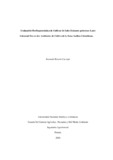Please use this identifier to cite or link to this item:
https://repository.unad.edu.co/handle/10596/37237Full metadata record
| DC Field | Value | Language |
|---|---|---|
| dc.contributor.advisor | Polanco Manuel Francisco | |
| dc.coverage.spatial | cead_-_eje_cafetero | |
| dc.creator | Rincon carvajal, Bernardo | |
| dc.date.accessioned | 2020-10-24T15:33:51Z | |
| dc.date.available | 2020-10-24T15:33:51Z | |
| dc.date.created | 2020-03-02 | |
| dc.identifier.uri | https://repository.unad.edu.co/handle/10596/37237 | |
| dc.description.abstract | En este documento se presentan los resultados obtenidos de la evaluación morfoagronómica del hibrido obtenido producto del retrocruzamiento tres RC3, entre materiales avanzados, de las variedades de lulo (Solanum quitoenses Lam), entre los parentales lulo La Selva Pl11 y lulo Castillo Larga Vida, evaluados en dos ambientes diferentes; uno en la vereda La Bella del municipio de Pereira a 1800 msnm de altura, representado al clima frio moderado y el otro, en el lote de investigaciones agrícolas del Centro de Agricultura y Biotecnología CIAB de la Universidad Nacional Abierta y a Distancia UNAD, en el municipio de Dosquebradas Risaralda a 1460 msnm de altura en representación del clima cálido. El primer cultivar de lulo mejorado y registrado en Colombia fue el lulo La Selva obtenido de una combinación interespecifica entre Solanum hirtum x Solanum quitoense, con lo que se logra un material de alta producción, tolerancia a plagas como el pasador del fruto (Neoleucinodes elegantalis) nematodos (Meloidogine sp.) y enfermedades como fusarium y con gran acogida por la agroindustria, pero poco acogido por el mercado en fresco, debido al rajamiento del fruto cuando madura y a su tamaño pequeño. Estos resultados corresponden a la segunda fase del programa de mejoramiento de lulo, de la Universidad Nacional Abierta y a Distancia UNAD, en el cual se ha logrado obtener un nuevo cultivariedad adaptado al clima medio y frio moderado, con tolerancia al ataque del pasador del fruto y al nematodo agallador, con excelentes características agronómicas y calidad comercial, dado por sus frutos. De gran tamaño, pulpa verde y de mayor concentración de grado brix y con tolerancia a los problemas fitosanitarios, como lo ofrecido por el material PL11 de Agrosavia. | |
| dc.format | ||
| dc.title | Evaluacion morfoagronomica de cultivar de Lulo(Solanum quitoensess Lam) Solo UNAD-DOS en dos ambientes de cultivo de la zona andina colombiana. | |
| dc.type | Proyecto de investigación | |
| dc.subject.keywords | Fruta, Plaga, Clima, Suelo | |
| dc.description.abstractenglish | This research work aims to study and analyze the results obtained from crosses and cross-breeding, among the varieties of lulo (solanum quitoense Lam), taking as parentals lulo the jungle and lulo long castle life, performed in two different environments, the location of these, were sidewalk the beautiful of the municipality of Pereira and the lot of agricultural research of the center of agriculture and Biotechnology CIAB of the National Open and Distance University UNAD, located in the municipality of Dosquebradas Risaralda. Lulo is one of the fruits of the Andean region, with great export opportunities to Europe; its juice is widely accepted in all Latin American countries and in the United States, being one of the fruits with more demand in both domestic and international markets. In spite of being a plant with many centuries of existence in our continent, it has not been achieved a complete domestication, because some agronomically not very pleasant characteristics are observed such as: thorns in the stems, branches and leaves, fruits covered by trichomes, dehiscence of the fruit, rapid oxidation of the juices, high number of berries (Lobo 2004) among others. These results correspond to the second phase of the lulo improvement program, of the Open and Distance University UNAD, which aims to provide producers with a lulo crop adapted to the medium and moderate cold climate, with tolerance to the attack of the pin of the fruit and the agallador nematode, with excellent agronomic and commercial quality characteristics, given by their fruits of higher concentration of degree brix. | |
| Appears in Collections: | Ingeniería Agroforestal | |
Files in This Item:
| File | Description | Size | Format | |
|---|---|---|---|---|
| brinconc.pdf | 1.03 MB | Adobe PDF |  View/Open |
Items in DSpace are protected by copyright, with all rights reserved, unless otherwise indicated.
